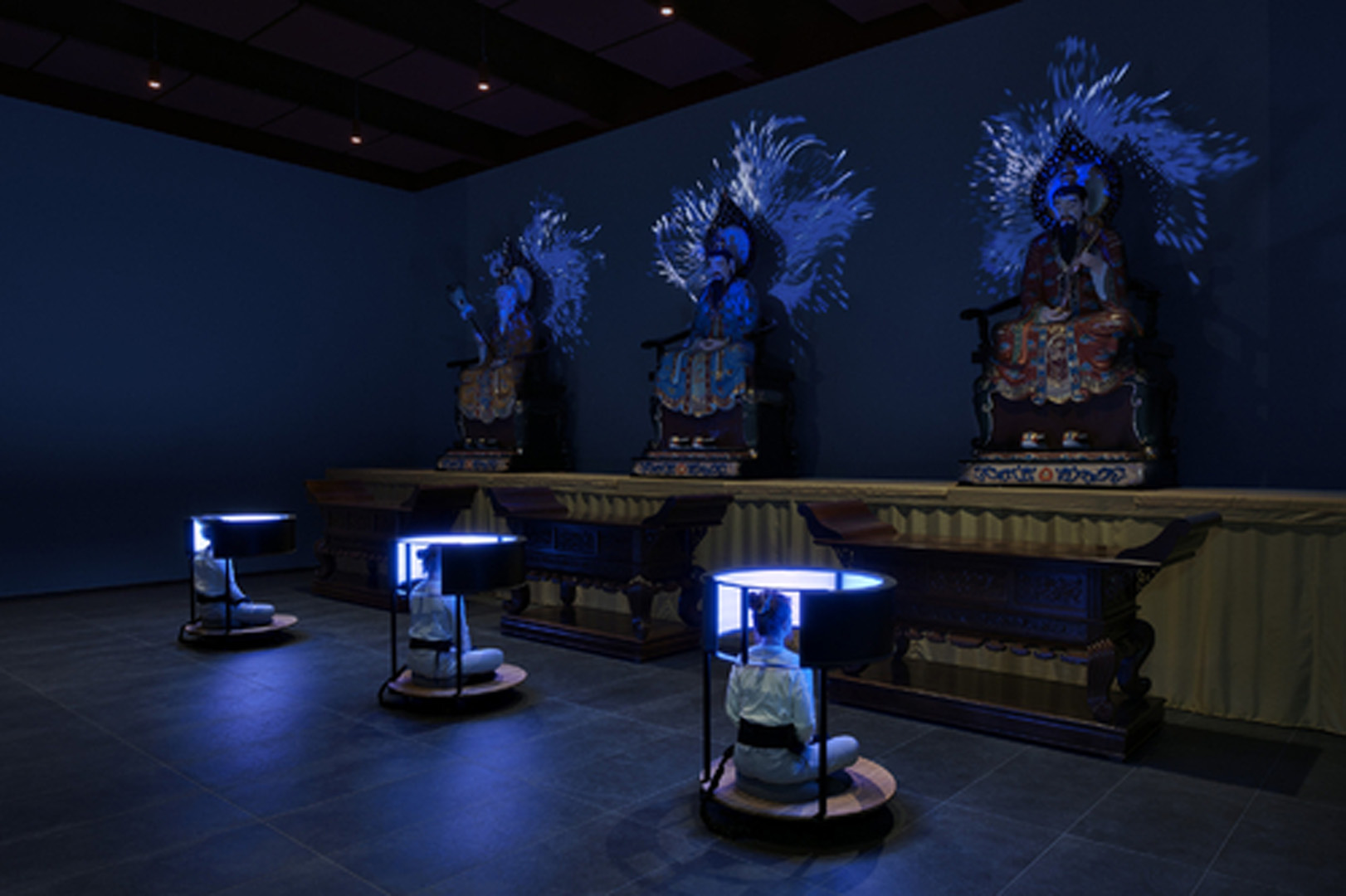“Ming Shan Digital Experience: Immersive Technology for Traditional Taoist Meditation” by Henchoz, Charvolin, Ribes, Défayes, Duchêne, et al. …
Conference:
Type(s):
Title:
- Ming Shan Digital Experience: Immersive Technology for Traditional Taoist Meditation
Presenter(s)/Author(s):
Abstract:
The Ming Shan Digital Experience is an immersive installation designed to support meditation in the context of a new Taoist center. Its creation confronted current academic literature on digital technology for meditation with the practical and cultural requirements of Taoist practice. Quantitative and qualitative learnings show the effectiveness of multimodal biofeedback on individual and collective meditative experience. Now instated in the Taoist center, the installation opens new perspectives for combining digital technology with ancient practice.
References:
1. Himani Anand. 2014. Effect of meditation (“OM” chanting) on alpha EEG and galvanic skin response: measurement of an altered state of consciousness. Indian J. Posit. Psychol. 5, 3 (2014), 255.
2. Andrew Bierman, Mariana Figueiro, and Mark Rea. 2011. Measuring and predicting eyelid spectral transmittance. J. Bio-med. Opt. 16, 6 (June 2011), 067011. DOI: https://doi.org/10.1117/1.3593151
3. Esko Dijk and Alina Weffers. 2010. Breathe with the ocean: a system for relaxation using audio, haptic and visual stimuli. EuroHaptics 2010, 47.
4. Pierre Flor-Henry, Yakov Shapiro, and Corine Sombrun. 2017. Brain changes during a shamanic trance: altered modes of consciousness, hemispheric laterality, and systemic psychobiology. Cogent Psychol. 4, 1 (2017), 1313522.
5. Xiang Gao, Hongbao Cao, Dong Ming, Hongzhi Qi, Xuemin Wang, Xiaolu Wang, Runge Chen, and Peng Zhou. 2014. Analysis of EEG activity in response to binaural beats with different frequencies. Int. J. Psychophysiol. 94, 3 (December 2014), 399–406. DOI: https://doi.org/10.1016/j.ijpsycho.2014.10.010
6. Christopher Gilbert. 2003. Clinical applications of breathing regulation: beyond anxiety management. Behav. Modif. 27, 5 (2003), 692–709.
7. Philippe Gouédard. 2014. La méditation taoïste. Librairie Eyrolles, Paris.
8. Nicolas Henchoz and Allison Crank. 2018. Digital Heritage: Bringing New Life to the Montreux Jazz Festival’s Audio-Visual Archives with Immersive Installations. Leonardo 51, 4 (August 2018), 375–380. DOI: https://doi.org/10.1162/leona01646
9. Kristina Höök, Martin Jonsson, Anna Ståhl, and Johanna Mercurio. 2016. Somaesthetic appreciation design. In Proceedings of the 2016 CHI Conference on Human Factors in Computing Systems (CHI ’16). Association for Computing Machinery, New York, NY, USA, 3131–3142.
10. Hiroshi Ishii, Craig Wisneski, Scott Brave, Andrew Dahley, Matt Gorbet, Brygg Ullmer, and Paul Yarin. 1998. ambientROOM: integrating ambient media with architectural space. In Proceedings of CHI 98 Conference Summary on Human Factors in Computing Systems (CHI ’98). Association for Computing Machinery, New York, NY, USA, 173–174.
11. Sarah Kenderdine and Jeffrey Shaw. 2017. Archives in Motion: Motion as Meaning. In Museum and Archive on the Move: Changing Cultural Institutions in the Digital Era. Oliver Grau, Wendy Coones, Viola Rühse (Eds.) (2017), 211–233.
12. Zhiqiang Liu and Zhengyang Li. 2018. The study on the design of Taoist cultural & creative products based on Wuhan intangible cultural heritage resources. In Proceedings of the 2018 2nd International Conference on Education Science and Economic Management (ICESEM 2018). Atlantis Press, 83–86. DOI: https://doi.org/10.2991/icesem-18.2018.19
13. Osten Bang Ping Mah, Yingwei Yan, Jonathan Song Yi Tan, Yi-Xuan Tan, Geralyn Qi Ying Tay, Da Jian Chiam, Yi-Chen Wang, Kenneth Dean, and Chen-Chieh Feng. 2019. Generating a virtual tour for the preservation of the (in)tangible cultural heritage of Tampines Chinese Temple in Singapore. J. Cult. Herit. 39, (September–October 2019), 202–211. DOI: https://doi.org/10.1016/j.culher.2019.04.004
14. Lizzie Muller, Greg Turner, George Khut, and Ernest Edmonds. 2006. Creating affective visualisations for a physiologically interactive artwork. IEEE, 651–657.
15. Sara Riggs, Christopher Wickens, Nadine Sarter, Lisa Thomas, Mark Nikolic, and Angelia Sebok. 2017. Multimodal information presentation in support of NextGen operations. Int. J. Aerosp. Psychol. 27, 1–2 (April 2017), 29–43. DOI: https://doi.org/10.1080/10508414.2017.1365608
16. Mary Ross, Paul Guthrie, and Justin-Claude Dumont. 2013. The impact of modulated, colored light on the autonomic nervous system. Adv. Mind Body Med. 27, 4 (2013), 7–16.
17. Nadine Sarter. 2006. Multimodal information presentation: design guidance and research challenges. Int. J. Ind. Ergon. 36, 5 (2006), 439–445.
18. Jaime Snyder, Mark Matthews, Jacqueline Chien, Pamara F. Chang, Emily Sun, Saeed Abdullah, and Geri Gay. 2015. MoodLight: exploring personal and social implications of ambient display of biosensor data. In Proceedings of the 18th ACM Conference on Computer Supported Cooperative Work & Social Computing (CSCW ’15), 143–153.
19. Anna Ståhl, Martin Jonsson, Johanna Mercurio, Anna Karlsson, Kristina Höök, and Eva-Carin Banka Johnson. 2016. The soma mat and breathing light. In Extended Abstracts on Human Factors in Computing Systems (CHI EA ’16), 305–308.
20. Jay Vidyarthi and Bernhard Riecke. 2013. Mediated meditation: cultivating mindfulness with Sonic Cradle. In Proceedings of CHI’13 Extended Abstracts on Human Factors in Computing Systems (CHI EA ’13), 2305–2314.
21. Joanneke Weerdmeester, Marieke van Rooij, Owen Harris, Niki Smit, Rutger Engels, and Isabela Granic. 2017. Exploring the role of self-efficacy in biofeedback video games. In Extended Abstracts Publication of the Annual Symposium on Computer-Human Interaction in Play (CHI PLAY ’17), 453–461.
22. Mark Weiser and John Seely Brown. 1995. Designing calm technology. PowerGrid J. 1 (1995).
23. Kanit Wongsuphasawat, Alex Gamburg, and Neema Moraveji. 2012. You can’t force calm: designing and evaluating respiratory regulating interfaces for calming technology. In Adjunct Proceedings of the 25th Annual ACM Symposium on User Interface Software and Technology (UIST Adjunct Proceedings ’12), 69–70.
24. Bin Yu, Jun Hu, Mathias Funk, and Loe Feijs. 2018a. DeLight: biofeedback through ambient light for stress intervention and relaxation assistance. Pers. Ubiquitous Comput. 22, 4 (2018), 787–805.
25. Bin Yu, Jun Hu, Mathias Funk, Rong-Hao Liang, Mengru Xue, and Loe Feijs. 2018b. RESonance: lightweight, room-scale audio-visual biofeedback for immersive relaxation training. IEEE Access 6, (2018), 38336–38347.




